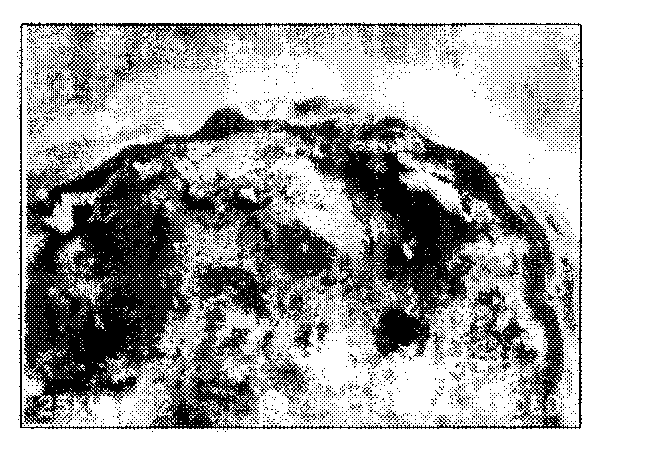Method for preparing polyurethane-polyurea coated fertilizer
A technology of polyurethane polyurea and polyurethane prepolymer, applied in fertilizer forms, fertilizer mixtures, fertilization devices, etc., can solve the problems of unsatisfactory controlled release effect, easy occurrence of pinholes and cracks, complicated implementation process, etc. Effects of leaching loss, good physical properties, wide range of raw materials
- Summary
- Abstract
- Description
- Claims
- Application Information
AI Technical Summary
Problems solved by technology
Method used
Image
Examples
Embodiment 1
[0044] Put 500g of polyoxypropylene glycol with a molecular weight of 1000 into a reactor equipped with a stirrer, a thermometer and a vacuum connecting pipe, stir and heat, and dehydrate for 3 hours at a vacuum degree of 0.08MPa and a temperature of 120°C. After cooling down to 50°C, 204.5g of toluene diisocyanate T-80 was added, the temperature was raised, and the reaction was carried out at 70°C. When the mass fraction of NCO reached 8.05%, vacuum defoaming was performed at 0.08 MPa for 15 min, and then the prepolymer was cooled to room temperature for use.
[0045] The chemical fertilizer is coated by the impact mixing spray method. In the spray drying equipment, the temperature of the chemical fertilizer is raised to 60°C, the fan frequency is set to 45Hz, the nozzle atomization pressure is 1.1Mpa, the inlet air temperature is 65°C, and the spraying speed is 0.4Kg / h. The above-mentioned prepolymer and the chain extender diethyltoluene diamine E-100 are mixed in the spray ...
Embodiment 2
[0047] Put 500g of polyoxypropylene diol with a molecular weight of 2000 into a reactor equipped with a stirrer, a thermometer and a vacuum connecting pipe, stir and heat, and dehydrate at a vacuum degree of 0.085MPa and a temperature of 110°C for 2.5h. After cooling down to 45°C, add 26.3g of epoxy resin E-44 and stir rapidly for 30min, then add 140.5g of toluene diisocyanate T-80, and heat up to 80°C for reaction. When the mass fraction of NCO reaches 7%, vacuum defoaming is performed at 0.085 MPa for 15 min, and then the prepolymer is cooled to room temperature for use.
[0048] The chemical fertilizer is coated by the impact mixing spray method. In the spray drying equipment, the temperature of the chemical fertilizer is raised to 60°C, the fan frequency is set to 45Hz, the nozzle atomization pressure is 1.0Mpa, the inlet air temperature is 70°C, and the spraying speed is 0.5Kg / h. The above prepolymer and the chain extender diethyltoluene diamine E-100 enter into the spray...
Embodiment 3
[0050] Put 500g of polyoxypropylene glycol with a molecular weight of 1000 into a reactor equipped with a stirrer, a thermometer and a vacuum connecting pipe, stir and heat, and dehydrate for 2 hours at a vacuum degree of 0.09MPa and a temperature of 100°C. After cooling down to 40°C, add 42.2g of starch, stir rapidly for 60min, then add 203.5g of toluene diisocyanate T-80, and raise the temperature to 85°C for reaction. When the mass fraction of NCO reached 7.5%, vacuum defoaming was performed at 0.09 MPa for 15 min, and then the prepolymer was cooled to room temperature for use.
[0051] The chemical fertilizer is coated by the impact mixing spray method. In the spray drying equipment, the temperature of the chemical fertilizer is raised to 60°C, the fan frequency is set to 45Hz, the nozzle atomization pressure is 0.8Mpa, the inlet air temperature is 75°C, and the spraying speed is 0.6Kg / h. The above-mentioned prepolymer and chain extender diethyltoluene diamine E-100 enter ...
PUM
 Login to View More
Login to View More Abstract
Description
Claims
Application Information
 Login to View More
Login to View More - R&D
- Intellectual Property
- Life Sciences
- Materials
- Tech Scout
- Unparalleled Data Quality
- Higher Quality Content
- 60% Fewer Hallucinations
Browse by: Latest US Patents, China's latest patents, Technical Efficacy Thesaurus, Application Domain, Technology Topic, Popular Technical Reports.
© 2025 PatSnap. All rights reserved.Legal|Privacy policy|Modern Slavery Act Transparency Statement|Sitemap|About US| Contact US: help@patsnap.com



